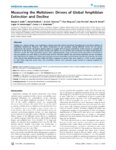|
|
Creator | Title | Description | Subject | Date |
| 1 |
 |
Sekercioglu, Cagan | The effects of climate change on tropical birds | Birds are among the most widely studied organisms on earth and represent an important indicator group for learning about the effects of climate change - particularly in regard to the effects of climate change on tropical ecosystems. In this review, we assess the potential impacts of climate change o... | | 2010-01-01 |
| 2 |
 |
Varner, Johanna; Dearing, Denise M. | The importance of biologically relevant microclimates in species distribution models and habitat suitability assessments | Predicting habitat suitability under climate change is vital to conserving biodiversity. However, current species distribution models rely on coarse scale climate data, whereas fine scale microclimate data may be necessary to assess habitat suitability and generate predictive models. Here, we evalua... | | 2013 |
| 3 |
 |
Ehleringer, James R.; Belnap, Jayne | Sensitivity of the Colorado plateau to change: climate, ecosystems, and society | The Colorado Plateau is located in the interior, dry end of two moisture trajectories coming from opposite directions, which have made this region a target for unusual climate fluctuations. A multidecadal drought event some 850 years ago may have eliminated maize cultivation by the first human settl... | Colorado Plateau; Biological crust; Climate change; Megadrought; Ranching; Dry crop productivity; Extractive industries; Pueblo Indians; Fremont culture | 2008 |
| 4 |
 |
Ehleringer, James R. | Responses of boreal conifers to climate fluctuations: indications from tree-ring widths and carbon isotope analyses | Spatial distribution and species composition of the boreal forest are expected to change under predicted climate change scenarios. Current research indicates that water limitations control the southern boundary of the central Canadian boreal forest and temperature limitations control the northern b... | Boreal forests; Carbon budget; Picea mariana; Pinus banksiana; Carbon isotopes | 1998 |
| 5 |
 |
Sekercioglu, Cagan | Promoting community-based bird monitoring in the tropics: conservation, research, environmental education, capacity-building, and local incomes | Long-term, locally-based biodiversity monitoring programs are essential for understanding and mitigating the effects of global change on tropical biodiversity while providing capacity-building, environmental education, and public outreach. However, these programs are lacking in most tropical countri... | | 2011-01-01 |
| 6 |
 |
Hultine, Kevin | Ecohydrological implications of woody plant encroachment | Increases in the abundance or density of woody plants in historically semiarid and arid grassland ecosystems have important ecological, hydrological, and socioeconomic implications. Using a simplified water-balance model, we propose a framework for conceptualizing how woody plant encroachment is li... | Carbon cycling; ecohydrology; evapotranspiration | 2005 |
| 7 |
 |
Ehleringer, James R. | Carbon isotope ratios in belowground carbon cycle processes | Analyses of carbon isotope ratios (δ13C) in soil organic matter (SOM) and soil respired CO2 provide insights into dynamics of the carbon cycle. δ13C analyses do not provide direct measures of soil CO2 efflux rates but are useful as a constraint in carbon cycle models. In many cases, δ13C analyses... | Below ground processes; Ecosystems; Carbon cycle; Carbon isotope ratio; Ecosystem processes; Global change; Soil organic carbon; Soil organic matter | 2000 |
| 8 |
 |
Sekercioglu, Cagan | Correlates of elevational specialisation in Southeast Asian tropical birds | The understanding of elevational selectivity in extremely rich tropical biotas is critical to the study of accelerating human-mediated environmental changes (e.g., deforestation and global climate warming). This paper explores the characteristics of Southeast Asian birds that are altitudinal special... | | 2012-01-01 |
| 9 |
 |
Sekercioglu, Cagan | Measuring the meltdown: drivers of global amphibian extinction and decline | Habitat loss, climate change, over-exploitation, disease and other factors have been hypothesised in the global decline of amphibian biodiversity. However, the relative importance of and synergies among different drivers are still poorly understood. We present the largest global analysis of roughly ... | | 2008-01-01 |
| 10 |
 |
Hultine, Kevin; Sperry, John S. | Transpiration and hydraulic strategies in a piñon-juniper woodland | Anthropogenic climate change is likely to alter the patterns of moisture availability globally. The consequences of these changes on species distributions and ecosystem function are largely unknown, but possibly predictable based on key ecophysiological differences among currently coexisting species... | Drought; Hydraulic transport model; Juniperus osteosperma; Plant water use; Sap flux; Species distributions | 2008 |
| 11 |
 |
Sekercioglu, Cagan | Importance of Ethiopian shade coffee farms for forest bird conservation | Coffee is the most important tropical commodity and is grown in high-priority areas for biological conservation. There is abundant literature on the conservation value of coffee farms internationally, but there has been little research on this topic in Africa. Ethiopia is a diverse and little-studie... | | 2014-01-01 |
| 12 |
 |
Ehleringer, James R. | Simplified GIS approach to modeling global leaf water isoscapes | The stable hydrogen (d2H) and oxygen (d18O) isotope ratios of organic and inorganic materials record biological and physical processes through the effects of substrate isotopic composition and fractionations that occur as reactions proceed. At large scales, these processes can exhibit spatial predic... | Oxygen isotope ratio; Hydrogen isotope ratio; Leaf water isoscapes; GIS | 2008 |
| 13 |
 |
Bowling, David R. | Ecological processes dominate the 13C land disequilibrium in a Rocky Mountain subalpine forest | Fossil fuel combustion has increased atmospheric CO2 by ≈ 115 μmol mol1 since 1750 and decreased its carbon isotope composition (δ13C) by 1.7-2‰(the 13C Suess effect). Because carbon is stored in the terrestrial biosphere for decades and longer, the δ13C of CO2 released by terrestrial ecosyst... | | 2014-01-01 |
| 14 |
 |
Ehleringer, James R.; Bush, Sarah Elizabeth | Ecophysiology of riparian cottonwood and willow before, during, and after two years of soil water removal | Riparian cottonwood/willow forest assemblages are highly valued in the southwestern United States for their wildlife habitat, biodiversity, and watershed protection. Yet these forests are under considerable threat from climate change impacts on water resources and land-use activities to support hum... | Riparian cottonwood; Riparian willow; Soil water removal; Coyote willow; Drought recovery; Populus fremontii; Riparian ecology; Red Butte Canyon Research Natural Area; Salix exigua; Stem sap flux; Leaf carbon isotope ratios | 2010 |
| 15 |
 |
Bowling, David R. | Interannual variation in seasonal drivers of soil respiration in a semi-arid Rocky Mountain meadow | Semi-arid ecosystems with annual moisture inputs dominated by snowmelt cover much of the western United States, and a better understanding of their seasonal drivers of soil respiration is needed to predict consequences of climatic change on soil CO2 efflux. We assessed the relative importance of tem... | | 2012-01-01 |
| 16 |
 |
Hultine, Kevin; Bush, Sarah Elizabeth; Ehleringer, James R. | Effect of gender on sap-flux-scaled transpiration in a dominant riparian tree species: Box elder (Acer negundo) | Acer negundo is a dioecious riparian tree species with a spatial segregation of the sexes along soil moisture gradients. Females are typically more common in wet sites along streams (typically F/M = 1.6), whereas males are more common in drier sites away from streams (typically F/M = 0.6). Spatial s... | Density; Ecosystem; Segregation | 2007 |
| 17 |
 |
Ehleringer, James R. | Intra- and interspecific variation for summer precipitation use in pinyon-juniper woodlands | In the arid southwest of North America, winter precipitation penetrates to deep soil layers, whereas summer"monsoon" precipitation generally wets only surface layers. Use of these spatially separated water sources was determined for three dominant tree species of the pinyon-juniper ecosystem at six ... | D/H ratios; Juniperus osteosperma; Pinus edulis; pinyon-juniper ecosystem; plant water sources; precipitation use; Quercus gambelii; roots; Photosynthetic gas exchange; Monsoon | 2000 |
| 18 |
 |
Ehleringer, James R. | ENSO effects on primary productivity in Southern Atacama desert | In the winter-rain southern Atacama Desert of the Coquimbo Region of Chile, El Niño - Southern Oscillation (ENSO) events modulate primary productivity. In this region, there are important changes in water availability between La Niña (dry) and El Niño (rainy) years. Using interannual comparison... | El Niño; Atacama Desert; Terrestrial ecosystems; Plant productivity | 2006 |
| 19 |
 |
Ehleringer, James R. | Potential adaptability and constraints of response to changing climates for Encelia farinosa var. phenicodonta from southern Baja California, Mexico | To examine the physiological adaptability of Encelia farinosa var. phenicodonta from southern Baja California, plants from Todos Santos, BCS were raised in central Arizona where winter-spring precipitation is greater than typically experienced by this variety. Plants were capable of high photosynthe... | Encelia farinosa var. phenicodonta; Ecophysiology | 1996 |
| 20 |
 |
Coley, Phyllis D.; Kursar, Thomas A. | Effects of weather on fungal abundance and richness among 25 communities in the Intermountain West | Because moisture and temperature influence the growth of fungi, characterizing weather conditions favorable for fungi may be used to predict the abundance and richness of fungi in habitats with different climate conditions. To estimate habitat favorability to fungi, we examined the relationship of f... | Intermountain West; Utah; Microclimate; Fungal prevalence | 2002 |
| 21 |
 |
Ehleringer, James R. | Tracing changes in ecosystem function under elevated carbon dioxide conditions | Responses of ecosystems to elevated levels of atmospheric carbon dioxide (CO2) remain a critical uncertainty in global change research. Two key unknown factors are the fate of carbon newly incorporated by photosynthesis into various pools within the ecosystem and the extent to which elevated CO2 is... | Elevated carbon dioxide; Stable isotopes; Radiocarbon; Global change; Terrestrial ecosystems | 2003 |
| 22 |
 |
Coley, Phyllis D.; Kursar, Thomas A. | Pests vs. drought as determinants of plant distribution along a tropical rainfall gradient | Understanding the mechanisms that shape the distribution of organisms can help explain patterns of local and regional biodiversity and predict the susceptibility of communities to environmental change. In the species-rich tropics, a gradient in rainfall between wet evergreen and dry seasonal forests... | Drought tolerance; Herbivory; Panama; Pathogen attack; Rainfall gradient; Tree distribution; Tropical forests | 2009 |
| 23 |
 |
Ehleringer, James R. | Carbon isotope dynamics in Abies amabilis stands in the Cascades | Carbon isotope ratios (d13C) of canopy air and carbon isotope discrimination at the ecosystem level were studied in three montane Pacific silver fir (Abies amabilis (Dougl. ex Loud.) Dougl. ex J. Forbes) stands, an old-growth and two younger stands. Spatial and temporal variations of canopy CO2 con... | Carbon isotopes; Pacific silver fir; Carbon budget; Soil respiration; Cascade Mountains | 1998 |
| 24 |
 |
Sekercioglu, Cagan | The worldwide variation in avian clutch size across species and space | Traits such as clutch size vary markedly across species and environmental gradients but have usually been investigated from either a comparative or a geographic perspective, respectively. We analyzed the global variation in clutch size across 5,290 bird species, excluding brood parasites and pelagic... | | 2008-01-01 |
| 25 |
 |
Ehleringer, James R.; Negus, Norman C. | Red Butte Canyon Research Natural Area: history, flora, geology, climate, and ecology | Red Butte Canyon is a protected, near pristine canyon entering Salt Lake Valley, Utah. It contains a well-developed riparian zone and a perennial stream; hillside vegetation ranges from grasslands on the lower limits to Douglas-fir and aspen stands at the upper elevations. In this paper we describe ... | Intermountain West; Grassland; Oak-maple; Plant adaptation; Red Butte Canyon Research Natural Area; Human impact | 1992 |

























